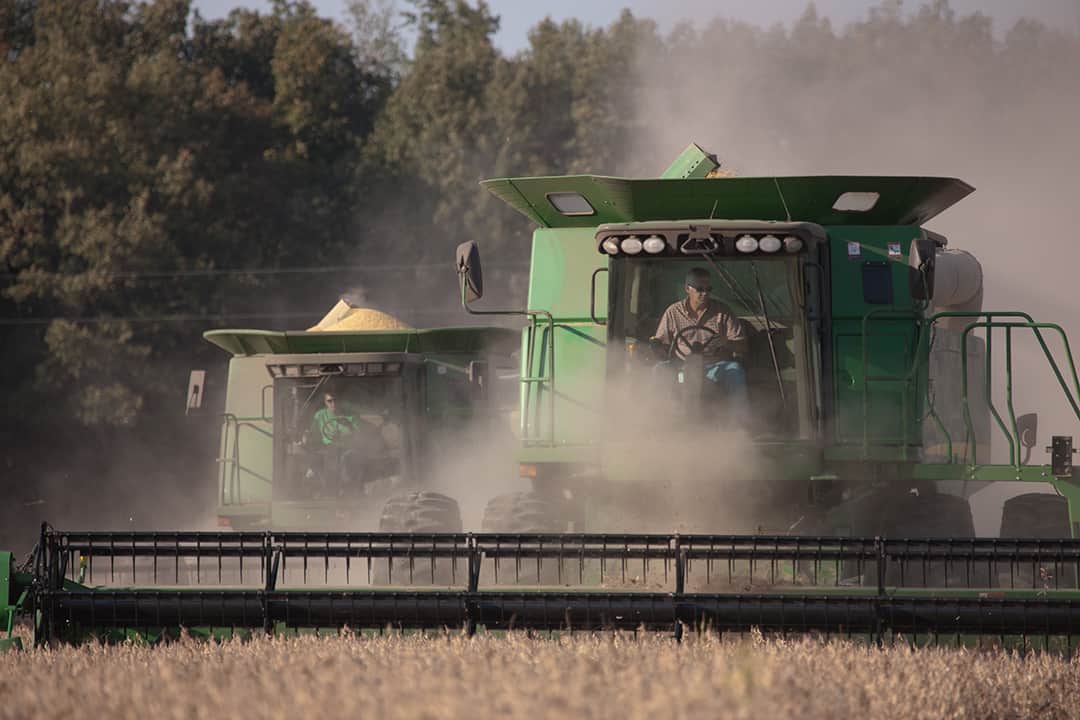
Life is full of mystery. We may know why the sky is blue, but why we are here, where missing socks go, and who wrote the book of love remain open questions. In light of President Trump’s shock-and-awe tariff campaign and the resulting blowback for the US farmers who voted for Trump and remain loyal, the question is: After so many decades of GOP devotion to the agenda of multinational grain and meat traders over the interests of the US and the folks back home, why do farmers still vote Republican?
Some cite the Second Amendment and Roe v. Wade. I don’t think it’s that simple. “Trump swung the farmer vote … by shrewdly mentioning a few very specific, mostly niche items—the vast majority of the country has never even heard of the Waters of the United States Rule, for example,” Dan Novowick wrote in Modern Farmer, November 23, 2016. Trump campaigned in favor of the renewable fuels standard (a hugely successful environmental policy that created a market for about 50 billion bushels US corn demand cumulatively over the past 10 years with an approximate farm-level corn value of $200 billion, while lowering consumer gas prices, cleaning the air, and reducing toxic gas additives) and against the estate tax (feared by farm families as land prices rise), the Affordable Care Act (farmers feared would bankrupt them with health-care payments for ag workers), the minimum wage (would price farm help out of reach for many), and the poorly understood water protection rule by the EPA, which critics call government overreach.
Huge investment—by ConAgra, Monsanto, Smithfield, and the like—in Fox News and toxic talk radio aimed specifically at rural America has born wildly profitable returns. These corporate propaganda funders aim to keep rural (and other working people) misinformed, confused, angry, and afraid, taking their distress out on one another, on their children, on strangers, and on themselves. Farmer suicides are up, as are “accidental” farm equipment rollover deaths, as are farm bankruptcies. Like the Kochs and Trump, corporate ag finds it useful to disrupt civil society, to keep farmers and working people from effectively organizing in the best interest of ourselves and our country, as opposed to the interests of corporations and the money class that owns them.

US ag producers, with arguably the most fertile ground in the world, pull off a magic act every single year. No work is more important, or honorable, than raising food for people to eat. But farmers are many, while buyers are few, so unlike virtually every other industry, ag producers cannot set the price for what they produce. Most US farmers have access to just one buyer close enough that hauling costs don’t eat up all the margin. A bountiful harvest ought to be cause to celebrate, but today it’s a disaster for all but the very largest of operations, driving prices at the farm gate down. When farmers sell at below cost of production, which has been the case far more often than not over the past 50 years, they lose money on every acre farmed, on every bushel and every hundredweight of meat produced. A loss times more volume is just a greater loss. Farmers are not stupid, but they have been down so long, many seriously do not know which way is up.
Soybeans are the largest export crop in the US, at $23 billion annually. Soybean prices have dropped $2.00 per bushel since Trump declared his tariffs, down from $10.00 per bushel, and China (Nebraska’s number one export market) announced it will buy no more US soybeans. CNBC reports North Dakota, expecting a bumper crop in 2018, has sold 70 percent of its food-grade soybeans to China. Now firm orders are cancelled—some orders were canceled on beans already en route to China. Other Asian markets bought some of these beans but at a huge discount. Buyers will now turn to Brazil, and even to Russia, for soybeans.
As with most all ag commodities, soybean profit margins are very thin. Cost of production is $9.51 per bushel. The price as I write is $8.44. Farmers who locked in part of their crop at a little over $10 may not panic quite yet, but producers who did not hedge (it’s a bet) and beginners with heavy land and equipment debt are looking at serious trouble.
Trump’s 25 percent tariff on imported steel will hurt the rural economy especially hard. Other industries will pass their higher costs along, but ag producers don’t get to set their own prices, remember? Higher prices for farm equipment and fewer equipment sales will further deplete major small-town revenue streams. Even Trump’s anti-immigration policies hurt ag producers. Of the 2.2 million ag workers in this country, a whopping 53 percent are undocumented, effectively criminalizing producers who must hire labor or lose their crops.
Some of these troubles predate this president, but Trump’s policies just pile on. A press release from the American Corn Growers Foundation notes “Globalization and the … ‘race-to-the-economic-bottom’ trade policy horse is so far out the barn door and down the road that we can’t even see the dust.” This president understands nothing of government and only wants to rule, but the clock cannot be turned back.
The US may be out of the Trans-Pacific Partnership and other trade agreements, but the rest of the world has resources and will gladly fill any opportunity the US wants to abdicate. My guess is Putin is egging Trump on with his trade war. “You show the bastards who’s the boss, Don!” Getting the US out onto the ice of isolationism and protectionism is clearly a part of Putin’s plan.
China today is a capitalist state, actively working to colonize the world. China owns Smithfield, formerly a US corporation, the largest meat processor on Earth. China has been investing heavily in Africa, in infrastructure and land—and has been moving in large numbers of Chinese farmers, partly to relieve population pressure back home. Many think of Africa as desertified and starving, but huge areas of tremendous fertility will not be left fallow for long.
Trump has no plan to address some of the biggest trade problems—the broken US trade advisory system whereby the foxes get to make henhouse policy or the high relative value of US currency, the problem of currency manipulation, and the fact that the US is the only major country with no VAT (value added tax)—a trifecta of disadvantage that robs US agriculture of as much as 50 percent of the value of commodities.
The tariff trade war will generate more new soybean and grain production infrastructure and marketing investment in South America and elsewhere. Russia is raising its rail transport subsidies this year. China’s high-speed rail technology is better than ours, and a Chinese railroad from the interior to the ports would open the millions of acres in South America that can be brought into production (with huge cost to the planet in environmental damage) equal to all the grain and oilseed production acres of the United States.
Mitigating the negative economic impact of the administration’s trade war is the administration’s responsibility. The tariff-imposed trade war on US grain sales and exports is forcing farmers to store grain rather than follow an orderly marketing strategy. USDA is obligated to mitigate the economic damage to farmers.
USDA-CCC should make grain storage payments to farmers for on-farm stored grain equal to annual commercial storage rates. Paying farmers the commercial storage rate is the logical way to compensate farmers, given that they will likely be forced to store grain for an extended period of time as a result of Trump’s tariff-imposed US export trade restrictions, foreign import grain buyer retaliation, and the future foreign grain production resulting from the US trade war that will stimulate foreign export competition for years.
Last week, the administration announced a $12-billion-dollar emergency relief package for the nation’s farmers, to include direct assistance, a food purchase and distribution program, and a trade promotion program. However, the National Farmers Union said today that US farmers lost $13 billion last month alone to trade disruptions.
This quick—and woefully inadequate—fix is a cynical attempt to get farmers to shut up about the damage from Trump’s trade war. It is hush money, a check in the mail before the midterms, which might well prove a disaster for the GOP.
Dear Farmers, please pay attention to the Farm Bill for actual evidence—and for real long-term relief—that the GOP has your back. If you reward their betrayal with your vote yet again, how will they learn? Aren’t you sick of getting bit by your own dogs?
A slightly different version of this piece originally appeared in the July/August 2018 issue of Nebraska Report.
